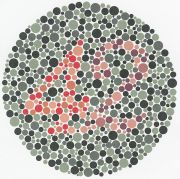
The French optician Jean Jouannic offers an online color blindness test based on 31 images. If you take your time and answer all the multiple choices, you will get rewarded with a nice reporting and probability indicators for the different types of color vision deficiency.
The images are based on two different color judgment systems. The first one consists of images showing a grid with a base color. Letters or signs in second color are integrated into those images. The test is easy, either you can see something or you can not. There is also always a second option offered, but these are just to find out if you’re trying to cheat or not.
You can see one of those grid images on the left side. Unfortunately I can’t tell you the solution for this one, because I can’t see anything but the grid.

The second system is based on color matching. An image shows different colored squares and the multiple choice offers a huge variety of different possible answers to choose from.
If you have normal color vision, it shouldn’t be a problem to find the right solution. But with a more or less severe type of color blindness you will have quite some difficulties to match the offered color names to the shown image. If you don’t know what to choose there is always an option to say, that you can’t find a good proposal.
Because it is often not easy to make your choice, you should find your answer with a process of elimination. Choose the one which sounds most probably. If you are colorblind, you are aware of the problem that you often can’t name colors correctly. With this elimination process it is definitely easier to find a matching solution.
Enough of information. Here is the direct link to the just described multiple choice color blindness test.
My test results:
I am either suffering a very strong form of red-weakness (protanomaly) or am completely red-blind (protanopia). Let’s have a look what my test results tell me:
- Correct answers: 21 (out of 31)
- General indicator of color blindness: 29%
- General indicator for color recognition: 71%
Only an indicator of 29% to be colorblind? In a first moment this looks strange to me, because I’m definitely colorblind—and not only just a mild form. I think the color matching images are the answer for this low percentage. Because of my color vision deficiency I can’t name any of the shown colors. But using the elimination process I still often found the right answer.
The next list shows all the indicators split up into the different types of color blindness.
- Deuteranopia indicator: 3%
- Deuteranomaly indicator: 29%
- Protanopia indicator: 39%
- Protanomaly indicator: 0%
- Tritanopia indicator: 0%
- Tritanomaly indicator: 0%
Ok, that looks good to me. A 39% percent chance to be red-blind is still a bit low, but at least it is ranking highest. A little strange is the fact, that there is a bigger chance to have some form of deuteranopia than to be red-weak.
What I like about this color blindness test:
It is available online, free to use, you can easily fill out the multiple choice forms and best of all, it shows you your results in a second and offers a whole range of indicators.
And what I don’t like so much:
The color matching images are too complicated to find your solution and don’t work as they should. I’m not so sure about the accuracy of the results, and apart from the test page everything else is just available in French.
But anyway, this is another great opportunity to find out more about your color vision. Maybe you like to try some other color blindness tests and compare the results. Or if you like, just share your indicators with us in the comments section.






